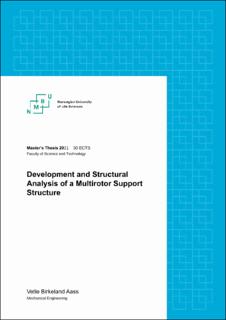| dc.contributor.advisor | Nygaard, Tor Anders | |
| dc.contributor.author | Aass, Vetle Birkeland | |
| dc.date.accessioned | 2021-10-26T07:36:14Z | |
| dc.date.available | 2021-10-26T07:36:14Z | |
| dc.date.issued | 2021 | |
| dc.identifier.uri | https://hdl.handle.net/11250/2825533 | |
| dc.description.abstract | Continuous advancement in wind turbine technology is a key factor in driving down the cost of energy from wind power. One idea that has been evaluated is the concept of having multiple rotors on a single support structure. This thesis investigates the structural integrity of a proposed design for a single rotor support in a multi rotor wind turbine. The support structure will be analyzed featuring both a two-bladed rotor as well as a four-bladed rotor. The structural analyses include fatigue, buckling and Von Mises stress assessments. The aim is to adjust the dimensions of the structural members such that they are in accordance with the design requirements.
The structure is modelled and analyzed using the 3DFloat simulation tool. Developed by the Wind Energy Department at the Institute for Energy Technology, 3DFloat is an aero-servo-hydro-elastic Finite-Element-Method code tailored for simulations of offshore structures in general, and offshore wind turbines in particular. Post-processing is executed using the Python Programming Language.
Fatigue assessments are carried out in accordance with the DNVGL-RP-C203. Buckling calculations are according to EN 1993-1-1 (2005):Eurocode 3: Design of steelstructures - Part 1-1: General rules and rules for buildings practice. The turbine’s structural response is investigated for normal and extreme wind conditions.
The results showed that the support structure featuring two blades experienced a higher vulnerability to fatigue. In extreme conditions the two structures exhibit similar structural responses to eachother.
The analyses culminated in the design of two support structures which have been verified against buckling and the Von Mises stress criterion, as well as being designed to have a fatigue life of more than 30 years. | en_US |
| dc.description.abstract | Kontinuerlig utvikling av vindturbinteknologi er en nøkkelfaktor i å drive ned prisen på energi fra vindkraft. Én Idé som har blitt evaluert er konseptet som innebærer å ha flere rotorer på én enkelt bærende struktur. Denne avhandlingen undersøker den strukturelle integriteten i en foreslått støttestruktur for én slik rotor i en multirotor vindturbin. Støttestrukturen vil bli analysert for både to og fire blader. Den strukturelle analysen inkluderer utmatting, knekking og Von Mises spenningsevaluering. Målet er å justere dimensjonene på konstruksjonsdelene slik at de er i tråd med designkravene.
Strukturen er modellert og analysert ved å bruke simuleringsverktøyet 3DFloat. 3DFloat er en aero-servo-hydro-elastic Finite-Element-Method kode skreddersydd for simuleringer av offshore strukturer generelt, og offshore vindturbiner spesielt, utviklet på Instituttet for Energiteknikk. Postprosessering er gjennomført i programmeringsspråket Python.
Utmattingsberegninger er gjennomført i tråd med DNVGL-RP-C203. Knekkeberegninger er i samsvar med EN 1993-1-1 (2005):Eurocode 3: Design of steelstructures -Part 1-1: General rules and rules for buildings practice. Turbinens strukturelle respons er undersøkt for både vanlige og ekstreme vindhastigheter.
Resultatene viste at strukturen hadde kortere utmattingslevetid når den opererte med to blader. I ekstreme vindforhold utviser strukturene lik strukturell respons med hverandre.
Analysen kulminerte i dimensjoneringen av to støttestrukturer som har blitt verifisert mot knekking og Von Mises spenningsberegninger, i tillegg til å være dimensjonert for å ha mer enn 30 års utmattingslevetid. | en_US |
| dc.language.iso | eng | en_US |
| dc.publisher | Norwegian University of Life Sciences, Ås | en_US |
| dc.rights | Attribution-NonCommercial-NoDerivatives 4.0 Internasjonal | * |
| dc.rights.uri | http://creativecommons.org/licenses/by-nc-nd/4.0/deed.no | * |
| dc.subject | Wind turbines | en_US |
| dc.subject | Buckling | en_US |
| dc.subject | DNVGL-RP-C203 | en_US |
| dc.title | Development and structural analysis of a multirotor support structure | en_US |
| dc.type | Master thesis | en_US |
| dc.relation.project | Continuous advancement in wind turbine technology is a key factor in driving down the cost of energy from wind power. One idea that has been evaluated is the concept of having multiple rotors on a single support structure. This thesis investigates the structural integrity of a proposed design for a single rotor support in a multi rotor wind turbine. The support structure will be analyzed featuring both a two-bladed rotor as well as a four-bladed rotor. The structural analyses include fatigue, buckling and Von Mises stress assessments. The aim is to adjust the dimensions of the structural members such that they are in accordance with the design requirements. The structure is modelled and analyzed using the 3DFloat simulation tool. Developed by the Wind Energy Department at the Institute for Energy Technology, 3DFloat is an aero-servo-hydro-elastic Finite-Element-Method code tailored for simulations of offshore structures in general, and offshore wind turbines in particular. Post-processing is executed using the Python Programming Language. Fatigue assessments are carried out in accordance with the DNVGL-RP-C203. Buckling calculations are according to EN 1993-1-1 (2005):Eurocode 3: Design of steelstructures - Part 1-1: General rules and rules for buildings practice. The turbine’s structural response is investigated for normal and extreme wind conditions. The results showed that the support structure featuring two blades experienced a higher vulnerability to fatigue. In extreme conditions the two structures exhibit similar structural responses to eachother. The analyses culminated in the design of two support structures which have been verified against buckling and the Von Mises stress criterion, as well as being designed to have a fatigue life of more than 30 years. | en_US |
| dc.description.localcode | M-MPP | en_US |

